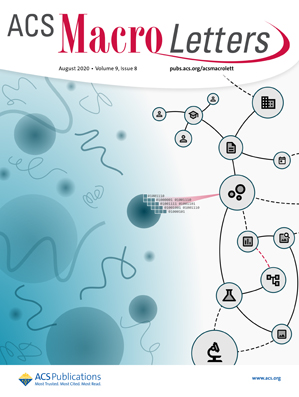Mechanically Triggered Multicolor Fluorescence Switching via Distance-Dependent FRET Effect.
IF 5.2
Q1 POLYMER SCIENCE
引用次数: 0
Abstract
Mechanoluminescent polymers capable of fluorescence modulation have attracted considerable interest for applications in stress-sensing and flexible electronics. Though Förster resonance energy transfer (FRET) has proven to be an effective mechanism for generating mechanoresponsive fluorescence changes, current systems predominantly depend on force-induced structural changes in chromophores. Herein, we report a mechanofluorochromic strategy exploiting force-modulated distance control between a FRET pair. A furan-maleimide Diels-Alder (DA) adduct covalently linked to pyrene (donor) and dansylamide (acceptor) was designed and incorporated at the midpoint of poly(methyl acrylate) (PMA) chains. Mechanical cleavage of the adduct spatially separates the FRET pair, effectively abolishing energy transfer and concurrently activating photoinduced electron transfer (PET). In acetonitrile, ultrasonication shifted the fluorescence from yellow to high-quality white light. Through changing the solvents, we demonstrate programmable multicolor switching. In toluene, the fluorescence evolves from green to cyan, while in DMF, rapid activation induced a transition from yellow to white emission. Each solvent system exhibits unique kinetic trajectories, enabling precise control over the chromatic response. This work demonstrates that controlled modulation of the FRET distance provides a versatile strategy for developing smart, multicolor mechanoluminescent materials without the need for a complex system design.机械触发多色荧光开关通过距离依赖的FRET效应。
具有荧光调制能力的机械发光聚合物在应力传感和柔性电子领域的应用引起了人们的极大兴趣。虽然Förster共振能量转移(FRET)已被证明是产生机械响应性荧光变化的有效机制,但目前的系统主要依赖于发色团中力诱导的结构变化。在此,我们报告了一种利用FRET对之间的力调制距离控制的机械荧光变色策略。设计了一种呋喃-马来酰亚胺Diels-Alder (DA)加合物,共价连接芘(给体)和丹酰胺(受体),并将其结合在聚丙烯酸甲酯(PMA)链的中点。加合物的机械裂解在空间上分离了FRET对,有效地消除了能量转移,同时激活了光致电子转移(PET)。在乙腈中,超声波将荧光从黄色转变为高质量的白光。通过改变溶剂,我们演示了可编程的多色开关。在甲苯中,荧光从绿色演变为青色,而在DMF中,快速激活诱导了从黄色到白色的转变。每种溶剂体系都表现出独特的动力学轨迹,从而能够精确控制色响应。这项工作表明,对FRET距离的控制调制为开发智能多色机械发光材料提供了一种通用策略,而无需复杂的系统设计。
本文章由计算机程序翻译,如有差异,请以英文原文为准。
求助全文
约1分钟内获得全文
求助全文
来源期刊
CiteScore
10.40
自引率
3.40%
发文量
209
审稿时长
1 months
期刊介绍:
ACS Macro Letters publishes research in all areas of contemporary soft matter science in which macromolecules play a key role, including nanotechnology, self-assembly, supramolecular chemistry, biomaterials, energy generation and storage, and renewable/sustainable materials. Submissions to ACS Macro Letters should justify clearly the rapid disclosure of the key elements of the study. The scope of the journal includes high-impact research of broad interest in all areas of polymer science and engineering, including cross-disciplinary research that interfaces with polymer science.
With the launch of ACS Macro Letters, all Communications that were formerly published in Macromolecules and Biomacromolecules will be published as Letters in ACS Macro Letters.

 求助内容:
求助内容: 应助结果提醒方式:
应助结果提醒方式:


